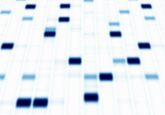Computer simulation allows design of microfluidic cell sorting device

Physical attributes of cells can be an important biomarker in medicine, with most current techniques sorting cells by their chemical properties. A group of researchers from the KTH Royal Institute of Technology (Stockholm, Sweden) have recently published work on a microfluidic device that may offer an alternative to these techniques – sorting cells according to their elasticity.
Two cells can have similar chemical properties but different physical attributes, and therefore the team envisaged this being a useful characteristic to enable cell sorting. They first carried out extensive numerical simulations, to design a microfluidic device capable of this sorting action.
The team describes when this ability would be useful – explaining how during malarial infection, red blood cells are physically altered – thus presenting the diagnostic applications of their work.
The device comprises a semi-cylindrical obstacle within a duct, which is attached to a diffuser that further enhances the device’s capabilities. Having been initially designed as a computer simulation, the team could optimize this arrangement before producing the physical device. They hope that this work will influence the way future microfluidic devices are designed.
Source: Zhu L, Rorai C, Mitra D, Brandt L. A microfluidic device to sort capsules by deformability: a numerical study. Soft Matter DOI: 10.1039/C4SM01097C (2014) (Epub ahead of print).




